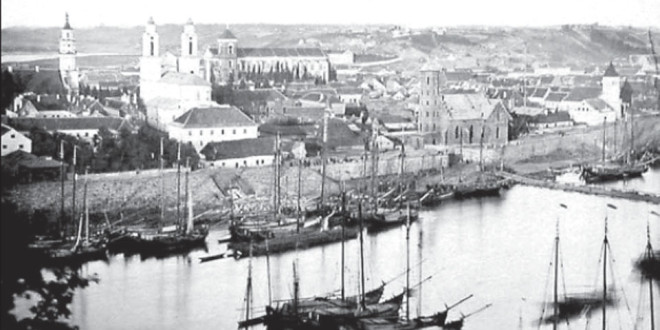By John J. Chernoski (Černiauskas)
REDISCOVERING A LOST HERITAGE
THE HOLOCAUST HAS NEARLY ERASED FROM OUR collective memory a people who were long a vibrant part of the Lithuanian scene – the Litvaks (Lithuanian Jews.) During the 14th century Grand DukeGediminas encouraged immigrants to assist in the economicgrowth of the Lithuanian empire, and, in return,he offered land and religious freedom. Jews were amongthose who accepted the invitation, and for more than sixhundred years they called Lithuania home. Indeed, duringthe 1700s and 1800s Judaic culture and religiousthought flourished in Vilnius (Vilna in Yiddish), andthe city was known as “Jerusalem of Lithuania” and “Jerusalemof the North.” At the end of the 19th century, Litvakscomprised over half the population of Kaunas (Kovnoin Yiddish.)
Kaunas sites such as the Ninth Fort, the SugiharaHouse, and the memorial marker of the Kaunas ghettoserve as somber reminders of the horrors that were suffered by the Jews during the Holocaust. Today, walkingthe streets of Kaunas, the only tangible evidence of Jewishlife is the Choral (Chief) Synagogue on Ožeškienės Street.
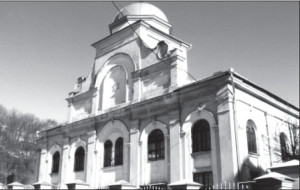
How does one connect with the past joys and successesof the Kaunas Litvaks or in other words, how do Ifind Kovno? Certainly, books are an avenue but actuallytouching, seeing, and feeling the past is a much moresatisfying experience. I decided to rediscover Jewish Kaunasby visiting some dilapidated buildings and structuresthat have been renovated to other uses but once were venues where the Litvaks came together.
Before beginning the description of my tour, somebackground information is appropriate. Kaunas was afamous fortress town during the early period of the GrandDuchy of Lithuania. With Gediminas’s invitation tooutsiders, Jews settled in Kaunas. Over the following centuries,as in many countries of Europe, Jews experienced varying periods of tolerance, intolerance,and outright hostility. In 1765the census recorded only about 1,000Litvaks in Kaunas. A hundred yearslater the number had increased toover 25,000. There were a couple ofreasons for the growth of Kaunas andthe influx of Jewish residents. In 1843Kaunas was transformed from beingmostly a backwater town to being thegovernment center of the RussianCzar’s administrative district for thearea. To fit its new role as a regionalcapital and the expected expansionof the area, a Kaunas town plan was implemented. At first Jews were prohibitedfrom living in the New Townarea, but in 1858 the restriction waslifted. Many of the buildings in Kaunasassociated with the Litvaks wereconstructed after the opening of thecity to all.
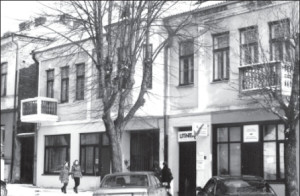
When you consider where Jewishpeople typically came together, myfirst thought was to search out housesof worship. Most Kaunas visitors areacquainted with the Choral Synagoguewhich was built in 1872 andis the oldest active synagogue in Lithuania.Whether called a synagogue or prayer house, there are many structuresin Kaunas that once served as aplace of worship. Judaism is notgoverned by one single hierarchalorganization. Rather, Judaism is generallyorganized in a congregationalstyle serving the needs of variousindividual groups. This diversity isreflected in Kaunas. Located at 12Gimnazijos Street is a rundownbuilding dating back to the middle1800s which once served as one ofthe Chasidic (AKA “Hasidic”) synagoguesin Kaunas. The Chasidic movementarose in Poland during themid-18th century with the purposesof serving the poor and uneducatedand simplifying Jewish rituals. Thisis in contrast to the Mussar movementthat developed in the 19thcentury which was orthodox in traditionand had a strong followingamong the Litvaks.
Not only did various Jewish sectsbuild Kovno houses of worship, butvarious professions also built synagoguesfor their members. The“Meatmen” School constructed asynagogue at 27a Daukšos Street in Old Town. While the building hasbeen renovated for another use, symbolic“Ten Commandments” areincluded on the exterior above thedoorways and windows. Keepingwith the theme of symbolism in therenovation of former Jewish housesof worship is an Old Town officebuilding at 7 Zamenhof Street whichwas once the Nieviazskis Synagogue.In New Town, at 28-30 GediminoStreet, is located the site of the NachlasIzrail Synagogue. Originally awooden structure, a stone synagoguewas constructed at the site in 1922.During the Soviet era the buildingwas renovated for nonreligious use,and the building does not include anyvisible reminder of its past purpose.However, in the building the JewishCommunity of Kaunas maintains anoffice (28b Gedimino.)
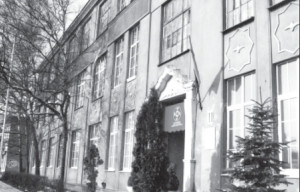
The Jewish people are well regardedfor their charity, and in Kaunas evidence of their past good worksremains. At 18 Mapų Street in OldTown is a dilapidated brick building.The structure was built in theearly 1900s, and it served as a communalkitchen for needy local Jewishresidents. Near the Catholic Cathedralin Old Town is a massive andseemingly abandoned building locatedat the intersection of Jakšto andPapilio streets. To most, the imposingstructure is just an “eye sore.”However, the building is likely thehallmark of the Litvaks’ charity inKaunas as it served as the Jewish hospital.Construction began in 1854and was funded by the Jewish community.As the population grew andthe demand for medical service increased,the building expanded overthe years to meet the needs of theJewish community. One of my Kaunasfriends sadly advised me that theold Jewish hospital is currently in thecenter of a dispute between two Jewishgroups over the true ownershipof the structure.
A strong commitment to educationis a tenet of Jewish life. Located at11 Mindaugo Way and near theNemunas River, is a large buildingwhich was the home of the Hebrewgymnasium (high school) from 1927to 1940. A plaque on the exteriorreminds passersby of the history ofthe building, and that most of thestudents perished in the Holocaust.
Another aspect of life in Kovno wasits economic activity. In Old Townthere is a rather unusual buildingon Muitinės Street, which originallyserved as Merkel Kadison’s meatshops. Constructed during 1852-1853, the structure contained severalmeat shops. Rather than the customersentering the shops from the streetside, they entered from the street through a gate into an interior courtyardwith the various shops, shopkeepers,and their meats facing thecourtyard. This mall-like arrangementwas unique in 19th centuryLithuania. Of special significance tome is that the building is now theVytautas Magnus University guesthouse,and it is my residence while I am teaching at the University. My room in the guesthouse was likely once the shop of a Litvak meatman, As I enter and leave the courtyard, I am walking in the footsteps of a multitude of Jewish patrons from long ago.
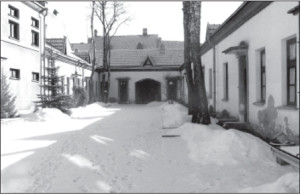
While the Litvaks may have spokenYiddish instead of Lithuanianand went to synagogue rather thanto church, they included amongtheir number professionals, farmers,tradesmen, workers, students, andbeggars. In short, they were much likeeveryone else. Thus, during my questto find Kovno, I generally avoidedfocusing on a particular individual.However, one day while walkingalong Laisvės Alėja (Liberty Boulevard)near the Metropolis Hotel, Icame upon the statue of a diminutiveman. Looking at the inscriptionat the base, I discovered it was a statueof Danielius Dolskis. I must admitthat the name meant nothing to me,so I decided to research Dolskis. Idiscovered he was an entertainer bornin 1891 to Jewish parents in Vilnius,and he spent his professional careeroutside Lithuania until 1929 whenhe came to Kaunas. Dolskis died onDecember 3, 1931. During this veryshort period, he earned the reputationas “the man who entertains Kaunas.”His acclaim was despite the factthat Dolskis did not speak Lithuanian.Rather with excellent dictionand memorization, Dolskis mesmerizedthe Kaunas audiences wheneverhe sang popular songs in Lithuanian.Indeed, Dolskis embodied the goodlife of Kovno. (There are recordingsof Dolskis in song and available tothe listener on-line at YouTube.)
There is much I probably overlookedor missed in my search forKovno (such as the derelict Jewishcemetery.) There is the expressionthat “Rome wasn’t built in a day.” Itis also likely that ancient Rome wasn’tfound in a day. On future trips toKaunas, I will continue my explorationand attempt to rediscover moreof Kovno. While Litvaks are now verysmall in number with a populationof less than 5,000 in Lithuania, theirstory is a part of the Lithuanian story.When you visit the city, take theopportunity to find Jewish Kaunas.Under the covers of the modern city,Kovno remains. It is there; you justhave to make some effort to find it.
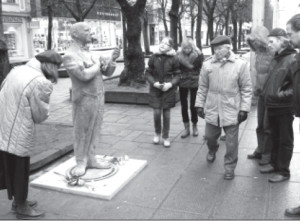
Lithuania has taken importantsteps to preserve the history of LithuanianJews. My principle source ofinformation in making my Kovnodiscovery trek and in preparing thisarticle was the book, Jewish CulturalHeritage in Lithuania, published bythe Lithuanian Department of CulturalHeritage. I highly recommendthe book to anyone who is interestedin a detailed and insightful historyof the Jewish experience in Lithuania.Other books of interest are The Litvaks – A Short History of the Jewsin Lithuania, and The Jews of Lithuania, Also, the Jewish Community in Lithuania maintains an informative website at www.litjews.org.
Indeed, the history and culturalheritage of the Litvaks are beingspread throughout Europe. Vilniuswas named as a 2009 European Capitalof Culture. As part of the yearlongcelebration, a Klezmer music festival,a Jewish song fest, and exhibitionsof Jewish Lithuania were included inthe program. Also, in August, the 3rdWorld Litvak Congress took place inVilnius to honor the city’s designation,the millennium of Lithuania,and the twentieth anniversary of theorganization, the Jewish Communityof Lithuania. The purpose of theWorld Litvak Congress was to bring together Litvaks in Lithuania and in the Diaspora and to focus upon and remember Jewish Lithuania. Yes, Jews were and remain part of theLithuanian experience. The Litvaksshould never be forgotten.
 DRAUGAS NEWS Lithuanian World Wide News in English
DRAUGAS NEWS Lithuanian World Wide News in English
